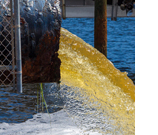Insights
 Environmental Pollution: Planning for Risks
Environmental Pollution: Planning for Risks
December 1, 2023
For business owners, an environmental pollution incident can result in stiff regulatory penalties and staggering expenses associated with cleanup or pollution mitigation. It is imperative that businesses adopt a proactive approach to risk management, helping to prevent potential incidents and minimize their financial and reputational impacts.
In this article, we explore common pollution risks and present an overview of the steps needed to adequately identify, assess, and mitigate these risks. At the core of risk management is environmental pollution liability insurance; to learn more about insurance solutions, visit our Environmental page.
What are Common Pollution Risks for Businesses?
Industrial processes, particularly in manufacturing, energy production, and transportation often pose various pollution risks, which can significantly impact the environment and human health. Some of the common pollution risks include:
- Air Pollution: Industries often emit gases like carbon dioxide, sulfur dioxide, nitrogen oxides, and volatile organic compounds (VOCs) into the atmosphere. These emissions can lead to smog, acid rain, and respiratory problems in humans.
- Water Pollution: Industrial activities can lead to the contamination of water bodies through the discharge of pollutants like heavy metals, chemicals, and untreated waste. This can harm aquatic life, disrupt ecosystems, and contaminate drinking water sources.
- Soil Contamination: The use and disposal of hazardous substances in industrial processes can result in soil contamination. This affects land fertility, can make the land unusable for agricultural purposes, and leads to the bioaccumulation of toxic substances in food chains.
- Chemical Hazards: Many industries use hazardous chemicals that can pose risks if not handled or stored properly. Accidental spills, leaks, or improper disposal can lead to environmental contamination and health hazards.
- Waste Management Issues: Improper disposal of industrial waste, including both solid and liquid waste, can lead to environmental pollution and health risks, especially if toxic elements are involved.
- Resource Depletion: Overuse of natural resources, like water and minerals, in industrial processes can lead to their depletion and ecological imbalance.
- Biological Hazards: Some industries may deal with biological materials that can be harmful if released into the environment, such as in biotechnology or pharmaceutical industries.
A single incident, such as a chemical spill or accidental discharge of wastewater, can result in hundreds of thousands or even millions of dollars associated with containment, cleanup, and regulatory fines. Without the protection of environmental pollution liability insurance, a company could wind up in dire financial straits – putting business continuity at risk.
Managing Pollution Risks: A Comprehensive Plan to Protect Business Assets
An environmental pollution liability risk management plan is essential for any organization involved in activities that pose potential environmental risks. The key components of such a plan typically include:
- Risk Identification and Assessment: This involves identifying potential sources of environmental pollution and assessing the likelihood and severity of these risks. It includes evaluating processes, materials used, waste produced, and the potential for accidental releases or spills.
- Regulatory Compliance: Ensuring compliance with all relevant environmental laws and regulations is crucial. This includes obtaining necessary permits, following industry-specific guidelines, and adhering to national and international environmental standards.
- Pollution Prevention Strategies: Implementing proactive measures to reduce or eliminate pollution at the source. This might include process modifications, using less hazardous materials, improving waste management practices, and investing in cleaner technologies.
- Emergency Response and Contingency Planning: Developing detailed plans for responding to environmental incidents such as chemical spills or uncontrolled releases. This includes establishing procedures for immediate response, communication plans, and coordination with local emergency services.
- Training and Awareness: Providing regular training for employees on environmental policies, safe handling of hazardous materials, and emergency response procedures. Regular training also has the effect of raising awareness about the environmental impacts of their activities and the importance of pollution prevention.
- Monitoring and Reporting: Regularly monitoring environmental performance and pollution levels. This also involves maintaining records and reporting to regulatory authorities as required.
Perhaps the most important component of pollution risk management is that of environmental pollution liability insurance. Business owners must work with an experienced insurance provider to identify appropriate coverage types and levels to protect critical business assets from loss if a discharge incident occurs. ◼

